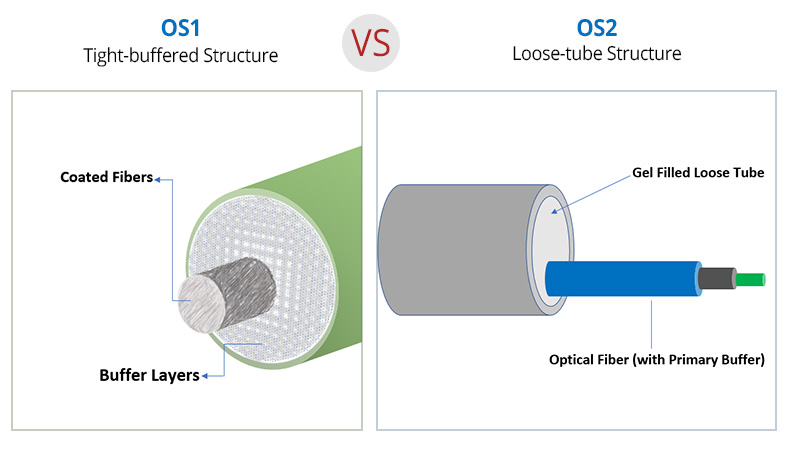The Ultimate Guide to Choose Between OS1 and OS2
Optical fiber cable consists of single-mode fiber cable and multimode fiber cable. Multimode fiber cable is generally used for short-range transmission within 500m, whereas single-mode fiber cable is used for long-range transmission beyond 10km. In the previous post, we have compared the different multimode cable types of OM1, OM2, OM3, OM4, and OM5. The single-mode fiber includes OS1 and OS2. Then, what are the differences between OS1 and OS2? How to choose between them? Find the answers in this article.
Differences Between OS1 Fiber and OS2 Fiber
What are the differences between OS1 and OS2? Next, this post will distinguish them from the aspects of industry-standard they are compliant with, their structure, applications, and specifications including wavelength, max distance, speed, and attenuation.
OS1 vs OS2: Compliant with Different Standard
Single mode fiber OS1 and OS2 compliant with different grades of G.652 standard. G.652 is an international standard that describes a series of characteristics of a single-mode optical fiber. G.652 plays an important role in standardizing the worldwide manufacturing and applications of fiber. The latest version was released in 2016, which is the ninth version of G.652 and has experienced 32 years since the first version that was released in 1984 by ITU-T (International Telecommunication Union). ITU-T G.652 is subdivided into G.652.A, G.652.B, G.652.C, and G.652.D. The single-mode fiber os1 is compliant with G.652.A and G.652.B (conventional), whereas single mode OS2 fiber is compliant with only G.652.C or G.652.D (low water peak).
Table 1: OS1 OS2 Attenuation Coefficient of Standard ITU-T G.652.A/B/C/D
OS1 vs OS2: Different Structure and Application
Single mode fiber OS1 is characteristic of a tight-buffered structure that features enclosing fiber in a thick polymer jacket. The main use of tight-buffered OS1 fiber is indoor buildings, campuses, moderate-length LAN/WAN connection, and direct burial.
Different from OS1 fiber, OS2 fiber adopts a loose-tube structure, which features enclosing everything within semi-rigid protective sleeves or tubes to protect the fiber core, cladding, and coating. Consequently, OS2 fiber is more suitable for harsh outdoor environments. The following elaborates why tight-buffered OS1 is more suitable for indoor applications while OS2 is more suitable for outdoor applications in detail.
OS1 is suitable for indoor applications because:
Flexible Connection and Termination - Tight-buffered OS1 fiber allows a contractor to be able to place a connector directly on the inner fiber thus providing flexibility and convenience for cable installation.
OS2 is suitable for outdoor applications because:
Water-proof - Loose-tube OS2 fiber designs with a water-blocking gel within the inner tubes so that it is able to stop the penetration of the pressure water. Especially in a low-temperature environment, the protection keeps water from freezing near the fiber and eliminates possible stress fractures further.
Better Tensile Performance - The outstanding characteristic of loose tube OS2 fiber is that Aramid yarn is adopted for the strength member to enhance the tensile strength of the fiber. The good tensile performance provides convenience for cable installation on one hand, also reduces fiber loss caused by tensile on the other hand.

Figure 1: OS1 Fiber Structure vs OS2 Fiber Structure
OS1 vs OS2: Specification Differences
Wavelength
OS2 is also referred to as low water peak single-mode fiber that can be considered an upgraded version of OS1. Compared with traditional single-mode fiber OS1, OS2 fiber suppresses the water peak caused by hydrogen ions at wavelength 1383±3nm and extends the work window.
In conclusion, while OS1 fiber is generally used in O-wavelength (Original-wavelength) of 1325-1360nm and C-wavelength (Conventional-wavelength) of 1530-1560nm, OS2 extends to four wavelengths, including O-wavelength, E-wavelength (Extended-wavelength) of 1360-1460nm, S-wavelength (Short-wavelength) of 1460-1530nm and C-wavelength.
Attenuation
OS2 fiber optimizes the attenuation and fiber dispersion in a full wavelength mainly because of its loose-tube structure. For 1310nm and 1550nm, the maximum attenuation of OS1 fiber is 1.0db/km, which is larger than 0.4db/km of OS2 fiber.
Speed and Maximum Distance
As the result of the lower attenuation, OS2 allows longer transmission distance and higher speed than OS1 single mode fiber. OS1 supports the maximum distance is only 10km, while OS2 fiber is able to reach 200km. Furthermore, OS2 single mode fiber allows transmission speed up to 40G/100GbE while single mode fiber OS1 is typically used in 1 to 10GbE speed.
How to Choose: Fiber OS1 vs OS2
The selection of fiber cable mainly depends on the application and environment. The factors such as ease of use, size, and cost are also to be considered. How to choose between single mode fiber types os1 vs os2? With the combination of the above analysis, the selection method can be concluded as follows.
Outdoor Use or Indoor Use - OS1 fiber is mainly used in the construction of indoor applications, such as campus networks and building networks. OS2 fiber is more suitable for outdoor applications including backhaul networks, external plants, FTTH, WDM/DWDM network, etc.
Distance - Considering fiber cost and attenuation, it is suggested that using OS1 fiber in transmission distance within 2km for low-cost of OS1, and choosing OS2 in transmission distance beyond 2km for better transmission performance.
I am more likely to recommend OS2, why?
After the above-mentioned comparison between these two types of single mode fibers, we have got clearly understood that OS2 is more suitable for long-haul and high-speed transmission for its advantages of good performance and fewer losses. It is considered a future-proof solution and gradually replaces OS1 today with the rapid development of high-bandwidth and high-speed optical communication. Furthermore, as the price of OS2 is not much higher than OS1, why not go for OS2 directly to a one-stop network fiber construction? And QSFPTEK provides cost-effective OS2 single mode fibers at the best price, welcome to consult via [email protected].
Related Article:
Single-Mode vs Multimode SFP Wiki and Guide










